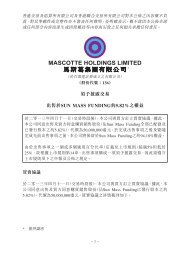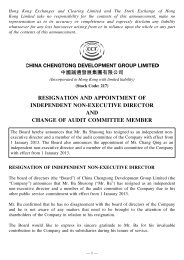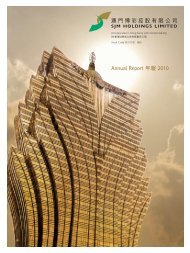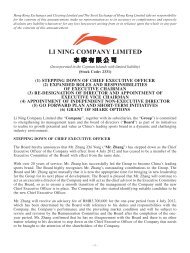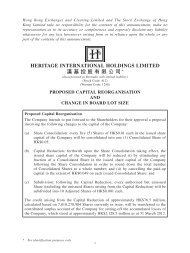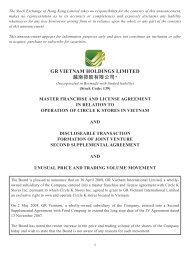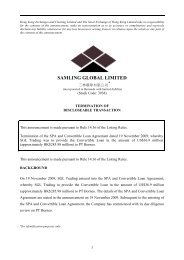年報 - HKExnews
年報 - HKExnews
年報 - HKExnews
Create successful ePaper yourself
Turn your PDF publications into a flip-book with our unique Google optimized e-Paper software.
NOTES TO THE FINANCIAL STATEMENTS<br />
<br />
31 March 2010 <br />
TEXWINCA HOLDINGS LIMITED ANNUAL REPORT 2010 <br />
2.4 SUMMARY OF SIGNIFICANT ACCOUNTING<br />
POLICIES (continued)<br />
Dividends<br />
Final dividends proposed by the directors are classified as<br />
a separate allocation of retained profits within the equity<br />
section of the statement of financial position, until they<br />
have been approved by the shareholders in a general<br />
meeting. When these dividends have been approved by<br />
the shareholders and declared, they are recognised as a<br />
liability.<br />
Interim dividends are simultaneously proposed and<br />
declared, because the Company’s bye-laws grant the<br />
directors the authority to declare interim dividends.<br />
Consequently, interim dividends are recognised<br />
immediately as a liability when they are proposed and<br />
declared.<br />
Employee benefits<br />
Share-based payment transactions<br />
The Company operates a share option scheme for the<br />
purpose of providing incentives and rewards to eligible<br />
participants who contribute to the success of the Group’s<br />
operations. Employees (including directors) of the Group<br />
receive remuneration in the form of share-based payment<br />
transactions, whereby employees render services as<br />
consideration for equity instruments (“equity-settled<br />
transactions”).<br />
The cost of equity-settled transactions with employees<br />
is measured by reference to the fair value at the date<br />
at which they are granted. In valuing equity-settled<br />
transactions, no account is taken of any performance<br />
conditions, other than conditions linked to the price of the<br />
shares of the Company (“market conditions”), if applicable.<br />
The cost of equity-settled transactions is recognised,<br />
together with a corresponding increase in equity, over the<br />
period in which the performance and/or service conditions<br />
are fulfilled. The cumulative expense recognised for equitysettled<br />
transactions at the end of each reporting period<br />
until the vesting date reflects the extent to which the<br />
vesting period has expired and the Group’s best estimate<br />
of the number of equity instruments that will ultimately<br />
vest. The charge or credit to the income statement for<br />
a period represents the movement in the cumulative<br />
expense recognised as at the beginning and end of that<br />
period.<br />
2.4 <br />
<br />
<br />
<br />
<br />
<br />
<br />
<br />
<br />
<br />
<br />
<br />
<br />
<br />
<br />
<br />
<br />
<br />
<br />
<br />
<br />
<br />
<br />
<br />
<br />
<br />
<br />
<br />
<br />
<br />
<br />
<br />
68





